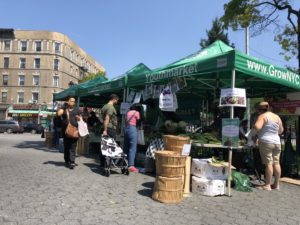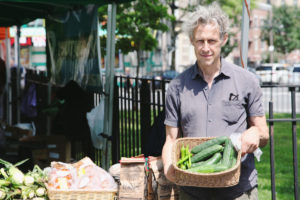Every Wednesday, the McKinley Square in central Morrisania is busy and crowded — even on gloomy days. The small food market in the square is filled with the smell of seasonal spinach, peaches, cucumbers and carrots. More than 100 people living in the South Bronx go to the weekly market to buy fresh produce because they can’t find affordable, quality fruits and vegetables elsewhere.
“It’s die-hard to find healthy food and fresh vegetables here,” said Carmen Camacho, 38, a Bronx native and a full-time stay home mother.
“Local supermarkets don’t have enough fruit and vegetable categories, they are not fresh, and not to mention they are also expensive,” she said.
The Morrisania area located in the South Bronx has long been known as a “food desert” for its lack of fresh produce. Instead, delis selling high-fat and high-sugar foods are far more common. Walking down East 169th Street, that runs through the center of Morrisania, one is surrounded on both sides by fast food restaurants such as Jimmy’s On The Go, Domino’s Pizza and Kennedy Fried Chicken. Up ahead, on Third Avenue is the 24-hour King Deli, selling burgers and sodas around the clock, while down at the McKinley Square is the Euro Piazza Restaurant. Every store has tempting posters with fast food on them, attracting passersby.
Bronx locals can easily find food here — but it’s more difficult for those who want to eat healthily.
“I have to wait until every Wednesday the Youthmarket come here to get some fruits and vegetables,” said Camacho.
The Youthmarket is run by GrowNYC’s Learn It Grow It Eat It program, which is aimed at improving the health of young people through nutrition education and improved food access in their schools and community. Founded in 2008, the Youthmarket in Morrisania is one of the longest-running Youthmarkets, now in its tenth year.

Youthmarket in the McKinley Square | Credit: Leafy Xiaoye Yan
Adults in Morrisania and Crotona are more likely to consume sugary drinks and are less likely to eat fruits and vegetables than adults citywide, according to the Bronx Community District 3 Health Profile. For example, 80% of residents here eat at least one serving of fruits or vegetables per day, compared to 95% in the best performing community.
Fruit and vegetable consumption is a complicated issue affected by price and availability, particularly among low-income adults. Beginning in 2005, the New York City Department of Health and Mental Hygiene used the social-ecological model to develop a multifaceted effort to increase fruit and vegetable access citywide, with an emphasis in low-income neighborhoods such as the South Bronx.
As of July 2015, 670 stores have agreed to promote healthier items as part of Shop Healthy. More than 300 of those stores have also agreed to increase access to healthier foods, according to the 2015 Food Metrics Report released by the New York City Mayor’s Office.

Fruits and Vegetables in a Bronx Supermarket | Credit: Leafy Xiaoye Yan
However, some Morrisania locals said they didn’t see substantive improvements in their neighborhood.
“Once a week is definitely not enough. It’s still too hard to get fresh produce here,” said Andy Foxe, 55, the owner of a local Barbershop. It took Foxe time even to think of other places he can buy vegetables or fruits besides the weekly Youthmarket.
More than just an inconvenience, the scarcity of healthy food can also lead to more health issues in the neighborhood. At 35%, the rate of obesity in Morrisania and Crotona is the highest in the city and more than four times the rate in Stuyvesant Town and Turtle Bay. Two-thirds of adults in the South Bronx are overweight, compared with one-half citywide. The diabetes rate in Morrisania and Crotona is 16%, which ranks the third highest among all New York City Districts, according to the latest Government Health Report.
“Obesity is a complex thing,” said Dr. Sharon Wardlaw at the New York Obesity Nutrition Research Center, “but limited access to healthy food could be a key factor leading to higher rates of obesity and diabetes in the Bronx.”
Limited access to healthy food means people in low-income communities suffer more from diet-related diseases like obesity and diabetes than those in higher-income neighborhoods with easy access to healthy food, particularly fresh fruits and vegetables, according to the Food Trust
Insufficient supply is not the only factor led to the scarcity of vegetables and fruits. Lorianne Santana, 18, a college student born and raised in Morrisania, believes that lack of consumer demand also plays an important role in the unhealthy diet.
“You can’t blame the store owners,” she said. “Most people only ask for fast-food because it is cheap and easy to buy, so that’s what all the delis and restaurants are going to sell.”
No demand, no supply. It’s a vicious cycle in Morrisania.
“The Bronx is in transition,” said Nicole Persaud, the senior attorney at New York Department of Agriculture and Markets. “With more programs ongoing, we aim to increase the access to fresh produce and improve the quality of life for Bronx residents.”
Most of the customers visiting the food market are familiar faces who live nearby and come every time, according to David Saphire, 56, one of the organizers of the Youthmarket.
“It helps with the food problem,” said Saphire, “but only in a very limited way since we are just one small market.”



